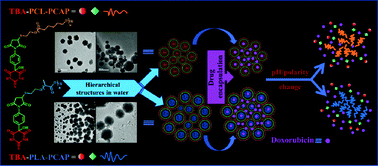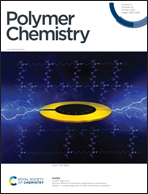Hierarchical self-assembled nanostructures of lactone-derived thiobarbiturate homopolymers for stimuli-responsive delivery applications†
Abstract
The synthesis of unique amphiphilic biodegradable molecular architectures from polylactone (polycaprolactone, polylactide)-derived thiobarbiturate homopolymers (TBA-PCL-PCAP, TBA-PLA-PCAP) and their characterization are described. Here, the lactones provided hydrophobicity, and the barbiturate provided hydrophilicity. To produce the compounds, Friedel–Crafts acylation and ring-opening polymerization (ROP) techniques were applied. The identities of the products were confirmed using 1H-NMR, 13C-NMR, and FT-IR spectroscopic techniques. These newly designed homopolymers self-assembled in aqueous solutions. Dynamic light scattering (DLS) and critical aggregation concentration (CAC) studies were carried out to confirm the formation of aggregates in solution. To investigate the morphologies of these homopolymers, transmission electron microscopy (TEM) and cryo-TEM studies were performed and they confirmed the formation of hierarchical superstructures. This unique amphiphilicity-induced homopolymer self-assembly was demonstrated for the first time for lactone-based polymers. First, the encapsulation of hydrophobic (Nile red) dye was done to prove the concept, and then the drug doxorubicin was investigated. A study of the dependence of the release of the drug on pH indicated the stimulus responsiveness of these innovative nanostructures. Analysis of the results revealed that, irrespective of the backbone, the barbiturate moiety was responsible for the self-assembled nanoaggregates and the related fascinating properties.



 Please wait while we load your content...
Please wait while we load your content...